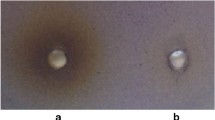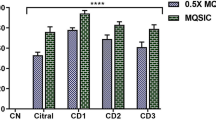Abstract
Shikonins (SK) and acetyl-shikonins (acetyl-SK) are known to possess great pharmaceutical potentials however, their ability to disrupt infectious bacterial communication system viz. quorum sensing (QS) remains unexplored. Therefore, the rationale behind this research was to investigate the QS-quenching potential of SK and acetyl-SK against C. violaceum through biofilm formation and violacein production assays. The quantitative evaluation was followed by the investigation of transcript abundance of violacein-regulating genes using RT-qPCR. Quantitative analysis indicated marked inhibition of QS-related traits with more obvious inhibition (87.5% biofilm, and 58% violacein inhibition) with 0.4 mM SK-treatment. Our RT-qPCR results displayed a substantially significant decrease in the expression level of CviR in SK-treated cells. Furthermore, SK treatment resulted in reduced transcript abundance of violacein biosynthetic genes such as vioB, vioC, and vioD. It was found that SK-induced QS inhibition in C. violaceum occurred through CviR down-regulation, which might further potentially disrupt the AHL-CviR receptor interaction. Both SK and acetyl-SK treatments were found to be ineffective against pre-mature biofilms, implying that SK-mediated biofilm attenuation is caused by interference with the expression of genes involved in biofilm attachment. In our study, SK strongly interfered with AHL-regulated physiological attributes while acetyl-SK was effective in inhibiting biofilm formation only. Collectively we found SK as anti-QS agents that mediate C. violaceum QS inhibition and bring new hope in combating C. violaceum infections. In addition, our findings can help prevent drug resistance in microbial pathogens in the future.
Graphic abstract







Similar content being viewed by others
References
Babula P, Adam V, Havel L, Kizek R (2009) Noteworthy secondary metabolites naphthoquinones: their occurrence, pharmacological properties and analysis. Curr Pharm Anal 5(1):47–68. https://doi.org/10.2174/157341209787314936
Bacha K, Tariku Y, Gebreyesus F, Zerihun S, Mohammed A, Weiland-Brauer N, Schmitz RA, Mulat M (2016) Antimicrobial and anti-quorum sensing activities of selected medicinal plants of Ethiopia: implication for development of potent antimicrobial agents. Bmc Microbiol. https://doi.org/10.1186/s12866-016-0765-9
Barriuso J (2015) Quorum sensing mechanisms in fungi. Aims Microbiol 1(1):37–47. https://doi.org/10.3934/microbiol.2015.1.37
Borges A, Serra S, Abreu AC, Saavedra MJ, Salgado A, Simoes M (2014) Evaluation of the effects of selected phytochemicals on quorum sensing inhibition and in vitro cytotoxicity. Biofouling 30(2):183–195. https://doi.org/10.1080/08927014.2013.852542
Brigham LA, Michaels PJ, Flores HE (1999) Cell-specific production and antimicrobial activity of naphthoquinones in roots of Lithospermum erythrorhizon. Plant Physiol 119(2):417–428. https://doi.org/10.1104/pp.119.2.417
Burt SA, Ojo-Fakunle VTA, Woertman J, Veldhuizen EJA (2014) The natural antimicrobial carvacrol inhibits quorum sensing in Chromobacterium violaceum and reduces bacterial biofilm formation at sub-lethal concentrations. PLoS ONE 9(4):e93414. https://doi.org/10.1371/journal.pone.0093414
Cao HH, Liu DY, Lai YC, Chen YY, Yu LZ, Shao M, Liu JS (2020) Inhibition of the STAT3 signaling pathway contributes to the anti-melanoma activities of shikonin. Front Pharmacol. https://doi.org/10.3389/fphar.2020.00748
Clinton A, Rumbaugh KP (2016) Interspecies and interkingdom signaling via quorum signals. Isr J Chem 56(5):265–272. https://doi.org/10.1002/ijch.201400132
De Kievit TR, Gillis R, Marx S, Brown C, Iglewski BH (2001) Quorum-sensing genes in Pseudomonas aeruginosa biofilms: their role and expression patterns. Appl Environ Microbiol 67(4):1865–1873. https://doi.org/10.1128/Aem.67.4.1865-1873.2001
Dickschat JS (2010) Quorum sensing and bacterial biofilms. Nat Prod Rep 27(3):343–369. https://doi.org/10.1039/b804469b
Flemming HC, Wingender J (2010) The biofilm matrix. Nat Rev Microbiol 8(9):623–633. https://doi.org/10.1038/nrmicro2415
Fuqua C, Greenberg EP (2002) Listening in on bacteria: acyl-homoserine lactone signalling. Nat Rev Mol Cell Biol 3(9):685–695. https://doi.org/10.1038/nrm907
Ghosh R, Tiwary BK, Kumar A, Chakraborty R (2014a) Guava leaf extract inhibits quorum-sensing and Chromobacterium violaceum induced lysis of human hepatoma cells: whole transcriptome analysis reveals differential gene expression. PLoS ONE 9(9):e107703. https://doi.org/10.1371/journal.pone.0107703
Ghosh R, Tiwary BK, Kumar A, Chakraborty R (2014b) Guava leaf extract inhibits quorum-sensing and Chromobacterium violaceum induced lysis of human hepatoma cells: whole transcriptome analysis reveals differential gene expression. PLoS ONE 9(9):e107703. https://doi.org/10.1371/journal.pone.0107703
Guardabassi L (2017) Antimicrobial resistance: a global threat with remarkable geographical differences. N Z Vet J 65(2):57–59. https://doi.org/10.1080/00480169.2017.1270645
Hammer BK, Bassler BL (2003) Quorum sensing controls biofilm formation in Vibrio cholerae. Mol Microbiol 50(1):101–114. https://doi.org/10.1046/j.1365-2958.2003.03688.x
Koh KH, Tham FY (2011) Screening of traditional Chinese medicinal plants for quorum-sensing inhibitors activity. J Microbiol Immunol 44(2):144–148. https://doi.org/10.1016/j.jmii.2009.10.001
Kumari A, Naidoo D, Baskaran P, Dolezal K, Nisler J, Van Staden J (2018) Phenolic and flavonoid production and antimicrobial activity of Gymnosporia buxifolia (L.) Szyszyl cell cultures. Plant Growth Regul 86(3):333–338. https://doi.org/10.1007/s10725-018-0432-2
Lin HY, Han HW, Wang YS, He DL, Sun WX, Feng L, Wen ZL, Yang MK, Lu GH, Wang XM, Qi JL, Yang YH (2020) Shikonin and 4-hydroxytamoxifen synergistically inhibit the proliferation of breast cancer cells through activating apoptosis signaling pathway in vitro and in vivo. Chin Med-Uk. https://doi.org/10.1186/s13020-020-00305-1
Mahmoudi E, Tarzaban S, Khodaygan P (2014) Dual Behaviour of plants against bacterial quorum sensing: inhibition or excitation. J Plant Pathol 96(2):295–301
Manefield M, Rasmussen TB, Henzter M, Andersen JB, Steinberg P, Kjelleberg S, Givskov M (2002) Halogenated furanones inhibit quorum sensing through accelerated LuxR turnover. Microbiology 148:1119–1127. https://doi.org/10.1099/00221287-148-4-1119
Morohoshi T, Kato M, Fukamachi K, Kato N, Ikeda T (2008) N-Acylhomoserine lactone regulates violacein production in Chromobacterium violaceum type strain ATCC 12472. Fems Microbiol Lett 279(1):124–130. https://doi.org/10.1111/j.1574-6968.2007.01016.x
Nandy SK, Venkatesh KV (2014) Study of CFU for individual microorganisms in mixed cultures with a known ratio using MBRT. AMB Express. https://doi.org/10.1186/s13568-014-0038-7
Ng WL, Bassler BL (2009) Bacterial quorum-sensing network architectures. Annu Rev Genet 43:197–222. https://doi.org/10.1146/annurev-genet-102108-134304
Nithya C, Aravindraja C, Pandian SK (2010) Bacillus pumilus of Palk Bay origin inhibits quorum-sensing-mediated virulence factors in Gram-negative bacteria. Res Microbiol 161(4):293–304. https://doi.org/10.1016/j.resmic.2010.03.002
Packiavathy IASV, Agilandeswari P, Musthafa KS, Pandian SK, Ravi AV (2012) Antibiofilm and quorum sensing inhibitory potential of Cuminum cyminum and its secondary metabolite methyl eugenol against Gram negative bacterial pathogens. Food Res Int 45(1):85–92. https://doi.org/10.1016/j.foodres.2011.10.022
Parsek MR, Greenberg EP (2000) Acyl-homoserine lactone quorum sensing in Gram-negative bacteria: a signaling mechanism involved in associations with higher organisms. Proc Natl Acad Sci USA 97(16):8789–8793. https://doi.org/10.1073/pnas.97.16.8789
Patil SV, Jayamohan NS, Kumudini BS (2016) Strategic assessment of multiple plant growth promotion traits for shortlisting of fluorescent Pseudomonas spp. and seed priming against ragi blast disease. Plant Growth Regul 80(1):47–58. https://doi.org/10.1007/s10725-016-0171-1
Qin YH, da Silva JAT, Bi JH, Zhang SL, Hu GB (2011) Response of in vitro strawberry to antibiotics. Plant Growth Regul 65(1):183–193. https://doi.org/10.1007/s10725-011-9587-9
Raghupathi KR, Koodali RT, Manna AC (2011) Size-dependent bacterial growth inhibition and mechanism of antibacterial activity of zinc oxide nanoparticles. Langmuir 27(7):4020–4028. https://doi.org/10.1021/la104825u
Rahman MRT, Lou ZX, Yu FH, Wang P, Wang HX (2017) Anti-quorum sensing and anti-biofilm activity of Amomum tsaoko (Amommum tsao-ko Crevost et Lemarie) on foodborne pathogens. Saudi J Biol Sci 24(2):324–330. https://doi.org/10.1016/j.sjbs.2015.09.034
Rasmussen TB, Givskov M (2006) Quorum-sensing inhibitors as anti-pathogenic drugs. Int J Med Microbiol 296(2–3):149–161. https://doi.org/10.1016/j.ijmm.2006.02.005
Ravichandran V, Zhong L, Wang HL, Yu GL, Zhang YM, Li AY (2018) Virtual screening and biomolecular interactions of CviR-based quorum sensing inhibitors against Chromobacterium violaceum. Front Cell Infect Micrbiol. https://doi.org/10.3389/fcimb.2018.00292
Sagratini G, Cristalli G, Giardina D, Gioventu G, Maggi F, Ricciutelli M, Vittori S (2008) Alkannin/shikonin mixture from roots of Onosma echioides (L.) L.: extraction method study and quantification. J Sep Sci 31(6–7):945–952. https://doi.org/10.1002/jssc.200700408
Schmittgen TD, Livak KJ (2008) Analyzing real-time PCR data by the comparative C-T method. Nat Protoc 3(6):1101–1108. https://doi.org/10.1038/nprot.2008.73
Schneider R, Lockatell CV, Johnson D, Belas R (2002) Detection and mutation of a luxS-encoded autoinducer in Proteus mirabilis. Microbiology 148:773–782. https://doi.org/10.1099/00221287-148-3-773
Schuster M, Greenberg EP (2006) A network of networks: Quorum-sensing gene regulation in Pseudomonas aeruginosa. Int J Med Microbiol 296(2–3):73–81. https://doi.org/10.1016/j.ijmm.2006.01.036
Skoneczny D, Weston PA, Zhu X, Gurr GM, Callaway RM, Barrow RA, Weston LA (2017) Metabolic profiling and identification of shikonins in root periderm of two invasive Echium spp. weeds in Australia. Molecules 22(2):330. https://doi.org/10.3390/molecules22020330
Solaiman DKY, Ashby RD, Uknalis J (2017) Characterization of growth inhibition of oral bacteria by sophorolipid using a microplate-format assay. J Microbiol Methods 136:21–29. https://doi.org/10.1016/j.mimet.2017.02.012
Terada T, Kikuchi Y, Umekage S (2015) Improved bioassay for detecting autoinducer of Rhodovulum sulfidophilum. Aip Conf Proc 1649:67–70. https://doi.org/10.1063/1.4913546
Thenmozhi R, Nithyanand P, Rathna J, Pandian SK (2009) Antibiofilm activity of coral-associated bacteria against different clinical M serotypes of Streptococcus pyogenes. Fems Immunol Med Microbiol 57(3):284–294. https://doi.org/10.1111/j.1574-695X.2009.00613.x
Vu B, Chen M, Crawford RJ, Ivanova EP (2009) Bacterial extracellular polysaccharides involved in biofilm formation. Molecules 14(7):2535–2554. https://doi.org/10.3390/molecules14072535
Wang FF, Yao XS, Zhang YW, Tang JS (2019) Synthesis, biological function and evaluation of Shikonin in cancer therapy. Fitoterapia 134:329–339. https://doi.org/10.1016/j.fitote.2019.03.005
Wang W, Morohoshi T, Ikeda T, Chen L (2008) Inhibition of Lux quorum-sensing system by synthetic N-acyl-L-homoserine lactone analogous. Acta Biochim Biophys Sin (Shanghai) 40(12):1023–1028. https://doi.org/10.1111/j.1745-7270.2008.00490.x
Waters CM, Bassler BL (2005) Quorum sensing: cell-to-cell communication in bacteria. Annu Rev Cell Dev Biol 21:319–346. https://doi.org/10.1146/annurev.cellbio.21.012704.131001
Wright GD (2014) Something old, something new: revisiting natural products in antibiotic drug discovery. Can J Microbiol 60(3):147–154. https://doi.org/10.1139/cjm-2014-0063
Wu FY, Tang CY, Guo YM, Bian ZW, Fu JY, Lu GH, Qi JL, Pang YJ, Yang YH (2017) Transcriptome analysis explores genes related to shikonin biosynthesis in Lithospermeae plants and provides insights into Boraginales’ evolutionary history. Sci Rep-Uk. https://doi.org/10.1038/s41598-017-04750-1
Xiong W, Luo G, Zhou L, Zeng Y, Yang W (2009) In vitro and in vivo antitumor effects of acetylshikonin isolated from Arnebia euchroma (Royle) Johnst (Ruanzicao) cell suspension cultures. Chin Med 4:14. https://doi.org/10.1186/1749-8546-4-14
You JL, Xue XL, Cao LX, Lu X, Wang J, Zhang LX, Zhou SN (2007) Inhibition of Vibrio biofilm formation by a marine actinomycete strain A66. Appl Microbiol Biot 76(5):1137–1144. https://doi.org/10.1007/s00253-007-1074-x
Zhang RG, Pappas T, Brace JL, Miller PC, Oulmassov T, Molyneauz JM, Anderson JC, Bashkin JK, Winans SC, Joachimiak A (2002) Structure of a bacterial quorum-sensing transcription factor complexed with pheromone and DNA. Nature 417(6892):971–974. https://doi.org/10.1038/nature00833
Acknowledgements
This work was supported by the grants from the National Natural Science Foundation of China (U1903201, 31771413), and the Program for Changjiang Scholars and Innovative Research Team in University from the Ministry of Education of China (IRT_14R27).
Author information
Authors and Affiliations
Contributions
YHY, GHL, JLQ conceived and designed the experiments; AF, MKY, MYW, FA, ZLW performed the experiments; AF, MKY did data analysis; TMY, XXZ, XMH, HWH, HYL, XMW contributed to the resources; AF, MKY wrote the draft of manuscript; YHY, GHL, JLQ contributed to reviewing and editing the manuscript.
Corresponding authors
Ethics declarations
Conflict of interest
The authors declare that they have no conflict of interests. The funding sponsors had no role in the design of the study, collection, analyses, interpretation of the data, writing of the manuscript, and in the decision to publish the results.
Ethical approval
This article does not contain any studies with human participants or animals performed by any of the authors.
Additional information
Communicated by Naser A. Anjum.
Publisher's Note
Springer Nature remains neutral with regard to jurisdictional claims in published maps and institutional affiliations.
Supplementary Information
Below is the link to the electronic supplementary material.
Rights and permissions
About this article
Cite this article
Fazal, A., Yang, M., Wang, M. et al. Assessment of shikonin and acetyl-shikonin for mitigating quorum sensing potential of C. violaceum. Plant Growth Regul 94, 233–243 (2021). https://doi.org/10.1007/s10725-021-00712-w
Received:
Accepted:
Published:
Issue Date:
DOI: https://doi.org/10.1007/s10725-021-00712-w




